Sanitas SBC 26 User Manual [nl]
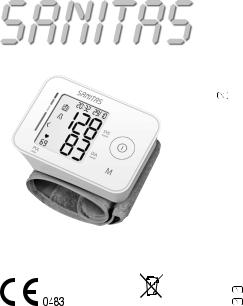
SBC 26
G ? Blood pressure monitor |
|
Instruction for Use............................................. |
2-15 |
K W Συσκευή μέτρησης πίεσης αίματς |
|
Οδηγίες χρήσεως............................................. |
16-30 |
Electromagnetic Compatibility Information............ |
31-33 |
|
|
|
|
Service-Hotline: |
|
|
|
|
|
|
|
||
|
|
|
|
G |
Tel.: 0800 931 0319 |
K Τηλ.: 211 198 4679 |
|
|
|
|
? |
Tel.: 1800 939 235 |
W Tel.: 0800 773 70 |
|
|
|
|
|||
|
|
|
|
|||
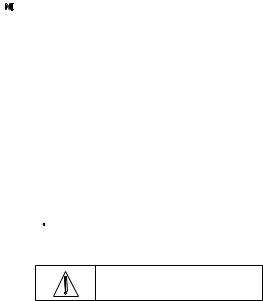
|
G ? |
|
ENGLISH |
|
|
Contents |
|
|
|
|
|
1. |
Getting to know your device ........................................ |
2 |
7. |
Error messages/troubleshooting ............................... |
12 |
2. |
Important notes ........................................................... |
2 |
8. |
Cleaning and storing the device and cuff .................. |
13 |
3. |
Unit description ........................................................... |
6 |
9. |
Technical specifications ............................................. |
13 |
4. |
Preparing for the measurement ................................... |
7 |
10. Warranty/ Service centre.......................................... |
14 |
|
5. |
Measuring blood pressure ........................................... |
8 |
|
|
|
6. |
Display and delete measured values ......................... |
11 |
|
|
|
|
|
|
|
|
|
Please read these instructions for use carefully and keep them for later use, be sure to make them accessible to other users and observe the information they contain.
1. Getting to know your device
Check that the packaging of the Sanitas SBC 26 blood pressure monitor has not been tampered with and make sure that all the required contents are present.
The wrist blood pressure monitor is used to carry out non-invasive measurement and monitoring of arterial blood pressure values in human adults. This allows you to quickly and easily measure your blood pressure, save the measurements and display the development of the
measurements. You are also warned of possible existing cardiac arrhythmia.
The recorded values are classified and evaluated graphically.
2. Important notes
 Signs and symbols
Signs and symbols
The following symbols are used in these instructions for use, on the packaging and on the type plate for the device and the accessories:
Attention
2

Note
Note on important information
Observe the instructions for use
Application part, type BF
|
|
Direct current |
|
|
Disposal in accordance with the Waste |
|
|
Electrical and Electronic Equipment EC |
|
|
Directive – WEEE |
|
|
Manufacturer |
|
Storage |
Permissible storage temperature and |
|
55°C |
humidity |
-20°C |
|
|
RH ≤85% |
|
|
|
|
|
|
Operating |
Permissible operating temperature and |
|
40°C |
humidity |
10°C |
|
|
RH ≤85% |
|
|
|
|
|
|
|
Protect from moisture |
|
|
Serial number |
The CE labelling certifies that the product complies with the essential require-  0483 ments of Directive 93/42/EEC on medi-
0483 ments of Directive 93/42/EEC on medi-
cal products.
 Notes on use
Notes on use
•In order to ensure comparable values, always measure your blood pressure at the same time of day.
•Before every measurement, relax for about five minutes.
•If you want to perform several measurements on the same person, wait five minutes between each measurement.
•Do not take a measurement within 30 minutes of eating, drinking, smoking or exercising.
•Repeat the measurement if you are unsure of the measured value.
•The measured values taken by you are for your information only – they are no substitute for a medical examination. Discuss the measured values with your doctor and never base any medical decisions on them (e.g. medicines and their administration).
•Do not use the blood pressure monitor on newborns, pregnant women or patients with pre-eclampsia.
•In the case of restricted circulation on the arm as a result of chronic or acute vascular diseases (including vascular constriction), the accuracy of the wrist meas-
3

urement is limited. In this case you should avoid using an upper arm blood pressure monitor.
•This device is not intended for use by people (including children) with restricted physical, sensory or mental skills or a lack of experience and/or a lack of knowledge, unless they are supervised by a person who has responsibility for their safety or they receive instructions from this person on how to use the device. Supervise children around the device to ensure they do not play with it.
•Cardiovascular diseases may lead to incorrect measurements or have a detrimental effect on measurement accuracy. The same also applies to very low blood pressure, diabetes, circulatory disorders and arrhythmias as well as chills or shaking.
•The blood pressure monitor must not be used in connection with a high-frequency surgical unit.
•Only use the device on people who have the specified wrist measurement for the device.
•Please note that when inflating, the functions of the limb in question may be impaired.
•During the blood pressure measurement, the blood circulation must not be stopped for an unnecessarily long time. If the device malfunctions remove the cuff from the arm.
•Do not allow sustained pressure in the cuff or frequent measurements. The resulting restriction of the blood flow may cause injury.
•Make sure that the cuff is not placed on an arm in which the arteries or veins are undergoing medical treatment, e.g. intravascular access or intravascular or therapy, or an arteriovenous (AV) shunt.
•Do not use the cuff on people who have undergone a mastectomy.
•Do not place the cuff over wounds as this may cause further injury.
•Place the cuff on your wrist only. Do not place the cuff on other parts of the body.
•The blood pressure monitor can only be operated with batteries.
•To conserve the batteries, the blood pressure monitor switches off automatically if you do not press any buttons for one minute.
•The device is only intended for the purpose described in these instructions for use. The manufacturer is not liable for damage resulting from improper or careless use.
 Instructions for storage and maintenance
Instructions for storage and maintenance
•The blood pressure monitor is made from precision and electronic components. The accuracy of the
measured values and service life of the device depend on its careful handling:
4

–Protect the device from impacts, humidity, dirt, marked temperature fluctuations and direct sunlight.
–Do not drop the device.
–Do not use the device in the vicinity of strong electromagnetic fields and keep it away from radio systems or mobile telephones.
•We recommend that the batteries be removed if the device will not be used for a prolonged period of time.
Notes on handling batteries
•If your skin or eyes come into contact with battery fluid, rinse the affected areas with water and seek medical assistance.
• Choking hazard! Small children may swallow and choke on batteries. Store the batteries out of the reach of small children.
Choking hazard! Small children may swallow and choke on batteries. Store the batteries out of the reach of small children.
•Observe the plus (+) and minus (-) polarity signs.
•If a battery has leaked, put on protective gloves and clean the battery compartment with a dry cloth.
•Protect batteries from excessive heat.
• Risk of explosion! Never throw batteries into a fire.
Risk of explosion! Never throw batteries into a fire.
•Do not charge or short-circuit batteries.
•If the device is not to be used for a relatively long period, take the batteries out of the battery compartment.
•Use identical or equivalent battery types only.
•Always replace all batteries at the same time.
•Do not use rechargeable batteries!
•Do not disassemble, split or crush the batteries.
 Instructions for repairs and disposal
Instructions for repairs and disposal
•Batteries do not belong in household waste. Please dispose of empty batteries at the collection points intended for this purpose.
•Do not open the device. Failure to comply will invalidate the warranty.
•Do not repair or adjust the device yourself. Proper operation can no longer be guaranteed in this case.
•Repairs must only be carried out by Customer Services or authorised suppliers.
Before making a claim, please check the batteries first and replace them if necessary.
•For environmental reasons, do not dispose of the de-
vice in the household waste at the end of its useful life. Dispose of the device at a suitable
local collection or recycling point. Dispose of the device in accordance with EC Directive –
WEEE (Waste Electrical and Electronic Equipment). If you have any questions, please contact the local authorities responsible for waste disposal.
5
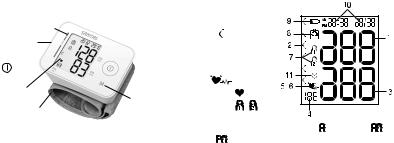
3. Unit description
1. |
Display |
3 |
|
2. |
Wrist cuff |
||
6 |
|||
3. |
Scale for classifying |
||
|
the measurements |
|
4.Start/stop button
5.Memory button M
6. Battery compart- |
1 |
ment lid |
|
2
 4
4
5
Information on the display:
1. |
Systolic pressure |
2. |
Classification of meas- |
|
urements |
3. |
Diastolic pressure |
4. |
Calculated pulse value |
5. |
Cardiac arrhythmia |
|
symbol |
6. |
Pulse symbol |
7. |
User memory / |
8. Memory space number/
memory display for average value ( A ), morning ( AM ), evening ( PM )
9.Battery replacement symbol


10.Time and date
11.Release air (arrow)
6
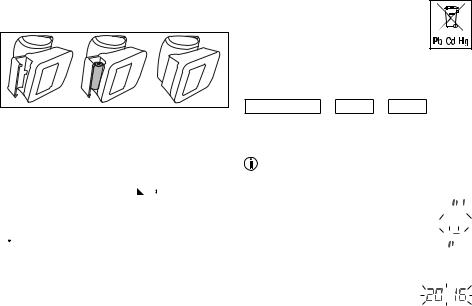
4. Preparing for the measurement
Inserting the batteries
•Remove the battery compartment lid on the left side of the device.
•Insert two 1.5 V micro (alkaline type LR03) batteries. Make sure that the batteries are inserted the correct way round. Do not use rechargeable batteries.
•Close the battery compartment lid again carefully.
If the battery replacement symbol |
|
is displayed, |
|
you can no longer perform any measurements and must replace all batteries.
 Battery disposal
Battery disposal
•The empty, completely flat batteries must be disposed of through specially designated collection boxes, recycling points or electronics retailers. You are legally required to dispose of the batteries.
• The codes below are printed on batteries containing harmful substances: Pb = Battery contains lead,
Cd = Batter contains cadmium, Hg = Battery contains mercury.
Setting the hour format, date and time
This menu allows you to set the following functions, one after another.
Hour format Date Time
It is essential to set the date and time. Otherwise, you will not be able to save your measured values correctly with a date and time and access them again later.
If you press and hold the memory button M you can set the values more quickly.
Hour format
• Press and hold the START/STOP button 




 for 5 seconds or insert the batteries. The full
for 5 seconds or insert the batteries. The full 


 display appears.
display appears. 


•Select the desired hour format using the 


 memory button M and confirm with the
memory button M and confirm with the 



START/STOP button  .
.
Date
The year flashes on the display.
7

•Select the desired year using the memory button M and confirm with the START/STOP button  .
.
The month flashes on the display.
• Select the desired month with the memory button M and confirm with the START/STOP button  .
.
The day flashes on the display. |
|
• Select the desired day with the memory button |
|
M and confirm with the START/STOP button |
. |
If the hour format is set as 12h, the day/month display sequence is reversed.
Time
The hours flash on the display.
• Select the desired hour using the memory button M and confirm with the START/ STOP button  .
.
The minutes flash on the display.
• Select the desired minute using the memory button M and confirm with the START/ STOP button  .
.
Once all the data has been set, the device switches off automatically.
5. Measuring blood pressure
Attach the cuff
Blood pressure may vary between the right and left arm, which may mean that the measured blood pressure values are different. Always perform the measurement on the same arm.
If the values between the two arms are significantly different, please consult your doctor to determine which arm should be used for the measurement.
1 |
2 |
3 |
|
|
cm |
|
|
1 |
•Expose your left wrist. Ensure that the circulation of the arm is not hindered by tight clothing or similar. Place the cuff on the inside of your wrist.
•Close the cuff with the hook-and-loop fastener so that the upper edge of the device is positioned approx. 1 cm underneath the heel of the hand.
•The cuff must be fitted tightly around the wrist, but
must not constrict.
8
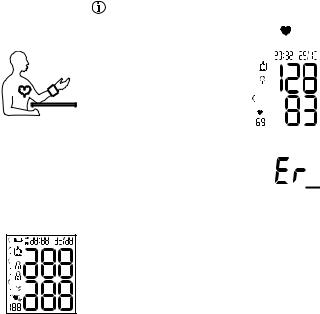
Adopting the correct posture
•Before every measurement, relax for about five minutes. Otherwise deviations can occur.
•You can take the measurement while sitting or lying down. To take your blood pres-
sure, make sure you are sitting
comfortably with your arms and back leaning on something. Do not cross your legs. Place your feet flat on the ground. Make sure
to rest your arm and move it. Always make sure that the cuff is at heart level. Otherwise significant deviations can occur. Relax your arm and the palm of your hand.
•To avoid falsifying the measurement, it is important to remain still during the measurement and not to speak.
Performing the blood pressure measurement
As described above, attach the cuff and adopt the posture in which you want to perform the measurement.
• Press the START/STOP button  to start the blood pressure monitor.
to start the blood pressure monitor.
All displays will illuminate briefly.
• The last measured value is dis-
played and the blood pressure monitor automatically begins the mea-
surement after 3 seconds.
You can cancel the measurement at any time by pressing the START/STOP button 
As soon as a pulse is found, the pulse symbol |
will be |
|
displayed. |
|
|
• The systolic pressure, diastolic |
|
|
pressure and pulse rate measure- |
|
|
ments are displayed. |
|
|
|
|
|
• _ appears if the measurement has not been performed properly. Observe the chapter
_ appears if the measurement has not been performed properly. Observe the chapter
on error messages/troubleshooting in these instructions for use and repeat the measurement.
•Now select the desired user memory by pressing the memory button M. If you do not select a user memory,
the measurement is stored in the most recently used
user memory. The relevant  or
or  symbol appears on the display.
symbol appears on the display.
•Press the START/STOP button to switch  off the blood pressure monitor. The measurement is then
off the blood pressure monitor. The measurement is then
stored in the selected user memory.
If you forget to turn off the device, it will switch off automatically after approx. 1 minute.
9
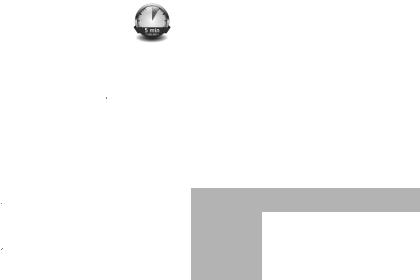
In this case too, the value is stored in the selected or most recently used user memory.
Wait at least 5 minutes before taking another measurement!
Evaluating results Cardiac arrhythmia:
This device can identify potential disruptions of the heart rhythm when measuring and if necessary, indicates this after the measurement with the symbol 
 .
.
This can be an indicator for arrhythmia. Arrhythmia is an illness in which the heart rhythm is abnormal because of flaws in the bioelectrical system that regulates the heartbeat. The symptoms (skipped or premature heart beats, pulse being slow or too fast) can be caused by factors such as heart disease, age, physical make-up, excess stimulants, stress or lack of sleep. Arrhythmia can only be determined through an examination by your doctor. If the symbol 
 is shown on the display after the measurement has been taken, repeat the measurement. Please ensure that you rest for 5 minutes beforehand and do not speak or move during the measurement.
is shown on the display after the measurement has been taken, repeat the measurement. Please ensure that you rest for 5 minutes beforehand and do not speak or move during the measurement.
If the symbol 
 appears frequently, please consult your doctor. Self-diagnosis and treatment based on the measurements can be dangerous. Always follow your GP’s instructions.
appears frequently, please consult your doctor. Self-diagnosis and treatment based on the measurements can be dangerous. Always follow your GP’s instructions.
Classification of measurements:
The measurements can be classified and evaluated in accordance with the following table.
However, these standard values serve only as a general guideline, as the individual blood pressure varies in different people and different age groups etc.
It is important to consult your doctor regularly for advice. Your doctor will tell you your individual values for normal blood pressure as well as the value above which your blood pressure is classified as dangerous.
The classification on the display and the scale on the unit show which category the recorded blood pressure values fall into. If the values of systole and diastole fall into two different categories (e.g. systole in the 'High normal' category and diastole in the 'Normal' category), the graphical classification on the device always shows the higher category; for the example given this would be 'High normal'.
Blood pressure |
Systole |
Diastole |
Action |
|
value category |
(in mmHg) |
(in mmHg) |
||
Setting 3: |
≥ 180 |
≥ 110 |
seek medical |
|
severe hyper- |
||||
attention |
||||
tension |
|
|
||
|
|
|
||
Setting 2: |
160 – 179 |
100 – 109 |
seek medical |
|
moderate hyper- |
||||
attention |
||||
tension |
|
|
||
|
|
|
10

Blood pressure |
Systole |
Diastole |
Action |
||
value category |
(in mmHg) |
(in mmHg) |
|||
Setting 1: |
140 – 159 |
90 – 99 |
regular monito- |
||
mild hyperten- |
|||||
ring by doctor |
|||||
sion |
|
|
|||
|
|
|
|||
High normal |
130 – 139 |
85 – 89 |
regular monito- |
||
ring by doctor |
|||||
|
|
|
|
||
Normal |
120 – 129 |
80 – 84 |
self-monitoring |
||
Optimal |
< 120 |
< 80 |
self-monitoring |
||
Source: WHO, 1999 (World Health Organization) |
|
||||
6. Display and delete measured values |
|||||
memory |
The results of every successful measurement are |
||||
60 measurements. |
|
|
|||
|
stored together with the date and time. The oldest |
||||
User |
measurement is overwritten in the event of more than |
||||
• To retrieve the measurement, press the memory |
|||||
|
|||||
button M.
User memory
Average values
A flashes on the display.
The average value of all saved measured values in this user memory is displayed.
To change the user memory, press and hold the memory button M for approx. 2 seconds.
• Press the memory button M.
AM flashes on the display.
The average value of the morning measurements for the last 7 days is displayed (morning: 5.00 a.m. – 9.00 a.m.).
• Press the memory button M.
PM flashes on the display.
The average value of the evening measurements for the last 7 days is displayed (evening: 6.00 p.m. – 8.00 p.m.).
11
